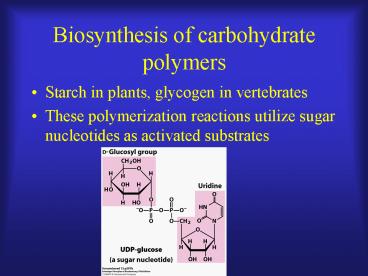Biosynthesis of carbohydrate polymers - PowerPoint PPT Presentation
1 / 32
Title:
Biosynthesis of carbohydrate polymers
Description:
Biosynthesis of carbohydrate polymers Starch in plants, glycogen in vertebrates These polymerization reactions utilize sugar nucleotides as activated substrates – PowerPoint PPT presentation
Number of Views:316
Avg rating:3.0/5.0
Title: Biosynthesis of carbohydrate polymers
1
Biosynthesis of carbohydrate polymers
- Starch in plants, glycogen in vertebrates
- These polymerization reactions utilize sugar
nucleotides as activated substrates
2
Why sugar nucleotides?
- Their formation is metabolically irreversible,
contributing to the irreversibility of pathways
in which they are intermediates - Nucleotide moiety provides potential interactions
- The substrate is activated because the
nucleotidyl group is a good leaving group - Tags the substrate, marking it for storage
3
Glycogen synthesis
- Glucose 6-phosphate is isomerized to glucose
1-phosphate by phosphoglucomutase - UDP-glucose pyrophosphorylase converts glucose
1-phosphate to UDP glucose using UTP and
producing pyrophosphate - Glycogen synthase attaches the UDP-glucose to the
nonredcuing end of a branched glycogen molecule
4
(No Transcript)
5
Making bonds in glycogen
- Glycogen synthase requires as a primer an (a1-4)
poly glucose chain or branch having at least
eight glucose residues. - Glycogen synthase cannot make the (a1-6) bonds
found at branch points these are formed by
glycosyl (4-6) transferase
6
Branching glycogen
- Glycosyl (4-6) transferase catalyzes the transfer
of a terminal fragment of six or seven glucose
residues from the non-reducing end of a glycogen
branch (having at least 11 residues) to the C6
hydroxyl group of a glucose residue at a more
interior position of a glycogen molecule,
generating a new branch
7
- Branches can subsequently be modified by glycogen
synthase - Branches increase solubility of glycogen
8
Where does the primer come from?
- Glycogenin builds primers for glycogen synthase
- Tyrosine-194 of this protein is the the site of
covalent glucose attachment (via UDP-glucose) - This modified glycogenin binds to glycogen
synthase, and the glycogen-bound glucose molecule
is extended up to seven residues using UDP-glucose
9
Glycogenin stays bound to the single reducing
end of glycogen as glycogen synthase takes over
10
Glycogen synthase and glycogen phosphorylase are
reciprocally regulated
- Details in text
11
Starch synthesis
- Analogous mechanism to glycogen synthase, but
starch synthase uses ADP-glucose
12
UDP-sugars are used in synthesis of other
biomolecules
- UDP-glucose for sucrose synthesis
- UDP-galactose for lactose synthesis
- UDP-glucose for vitamin C
- UDP-glucosamine for peptidoglycan
13
A discussion of carbohydrate biosynthesis must
encompass photosynthesis (chapter 20)
- Photosynthetic organisms assimilate or fix CO2
via the Calvin cycle - This cycle has three stages
- Fixation making 3-phosphoglycerate
- Reduction generating glyceraldehyde 3-phosphate
- Regeneration making ribulose 1, 5 bisphosphate
from triose phosphates
14
(No Transcript)
15
Stage I is mediated by Rubisco
- Rubisco is considered the most abundant protein
on Earth (located in chloroplast) - Rubisco stands for ribulose 1,5-bisphosphate
carboxylase/oxygenase
16
Rubisco catalyses the addition of CO2 to RuBP and
cleavage to 3-phosphoglycerate
17
Stage II
- The first step is catalyzed by 3-phosphoglycerate
kinase, which converts 3-phosphoglycerate to 1,3
bisphosphoglycerate using ATP - This compound is reduced using NADPH by
glyceraldehyde 3-phosphate dehydrogenase to
glyceraldehyde 3-phosphate
18
Stage II (cont)
- DHAP is formed by triose phosphate isomerase then
a portion transported to the cytosol for either
glycolytic metabolism or production of starch or
sucrose as a storage and transport media
19
(No Transcript)
20
Each CO2 fixed consumes a molecule of RuBP
- Therefore, RuBP must be regenerated.
- This is accomplished by a pathway including
variable number carbon intermediates reminiscent
of non-oxidative branch of PPP - Enzymes included in this stage include
transaldolase and transketolase
21
(No Transcript)
22
Transketolase reactions of the Calvin cycle
23
The result of the Calvin cycle
- The net result is the conversion of three
molecules of CO2 and one molecule of phosphate
into a molecule of triose phosphate. (One
molecule of glyceraldehyde 3-phosphate is the net
product of this carbon assimilation pathway) - This result comes from (uses) 6 NADPH and 9 ATP
supplied by photosynthesis (light)
24
(No Transcript)
25
An antiporter exchanges Pi with triose phosphates
26
(No Transcript)
27
Regulation of the Calvin cycle (Rubisco)
28
Four essential Calvin cycle enzymes are regulated
by light
- Ribulose 5-phosphate kinase
- Fructose 1,6-bisphosphatase
- Sedoheptulose 1,7 bisphosphatase
- Glyceraldehyde 3-phosphate dehydrogenase
- Regulation mediated by disulfide bond formation
and disruption
29
Rubisco is an oxygenase
- Evolution has made Rubisco somewhat of an
inefficient enzyme as it has a difficult time
discriminating between O2 and CO2 - Using oxygen results in a metabolically useless
molecule, phosphoglycolate - Carbon is salvaged from phosphoglycolate by
photorespiration
30
(No Transcript)
31
(No Transcript)
32
Plants can minimize photorespiration
- Photorespiration is wasteful
- Tropical plants employ a more complex pathway for
fixing CO2 - This pathway fixes CO2 on PEP using PEP
carboxylase and subsequently donates the CO2 to
Rubisco - These are known as C4 plants, in contrast to C3
plants which only use the Calvin cycle































